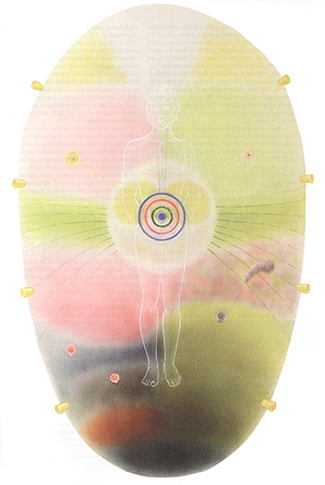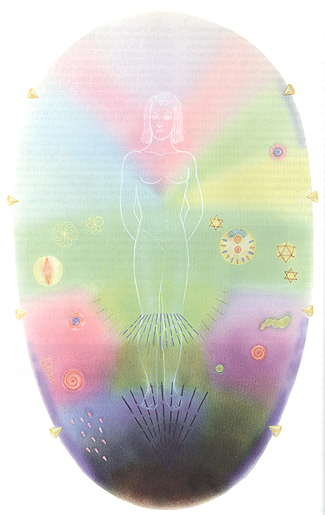Printed in the Spring 2013 issue of Quest magazine.
Citation: Finseth, Robyn Lawrence. "The Look of Love: A Theosophist's Vision" Quest 101. 2 (Spring 2013): pg. 68 - 71
By Robyn Lawrence Finseth
 Love is a spontaneous feeling experienced not intellectually but emotionally. It can most easily be felt when seeing a child or animal—a feeling that simply takes over the person who is observing. It is a moment when all feels right with the world. Time no longer seems to exist, and the world feels as if it is moving in slow motion.
Love is a spontaneous feeling experienced not intellectually but emotionally. It can most easily be felt when seeing a child or animal—a feeling that simply takes over the person who is observing. It is a moment when all feels right with the world. Time no longer seems to exist, and the world feels as if it is moving in slow motion.
As Theosophists, we accept and understand the reality of the aura. I was born with the gift of clairvoyant sight in a Theosophical family. I was guided in my youth by the naturopath Harry van Gelder; his sister, Dora Kunz, past president of the Theosophical Society in America; and my Theosophical family at the Portland Lodge. It is from this gift of sight that I address the concept of love as it is represented in the aura or subtle body.
According to Webster's dictionary, love is the "strong affection for . . . or attachment to . . . or devotion to a person or persons." Psychologists define love as the mutual attraction between two people. This often develops in three phases: initial attraction followed by attachment and commitment. Psychologists also point out that love stimulates the release of certain chemicals in the brain, such as dopamine, which arouses pleasure and motivation. Dopamine in turn stimulates emotional reactions, which are governed by the part of the brain known as the amygdala, and hence dictates the color of the aura.
The best book on auras was written by Dora Kunz and is entitled The Personal Aura. This book contains many illustrations depicting the subtle bodies of the aura, attempting to give the unsighted person the concept of exactly what a variety of emotions look like.
 Let's look first at the representation of the aura of a pregnant woman. This plate shows the color of a delicate pink both above and below the green band at the woman's center. This represents both the love of her family and the love of the unborn child. Although this plate shows a woman who is seven months pregnant, even at an earlier stage the vibrational energy between mother and unborn child is quite similar. When I am looking at an actual pregnant woman, there is a distinct look of the child, seen as a large, whirling presence, a difficult look to create in a two-dimensional form. The colors of both mother and child complement each other.
Let's look first at the representation of the aura of a pregnant woman. This plate shows the color of a delicate pink both above and below the green band at the woman's center. This represents both the love of her family and the love of the unborn child. Although this plate shows a woman who is seven months pregnant, even at an earlier stage the vibrational energy between mother and unborn child is quite similar. When I am looking at an actual pregnant woman, there is a distinct look of the child, seen as a large, whirling presence, a difficult look to create in a two-dimensional form. The colors of both mother and child complement each other.
In actuality, these colors are cloudlike, ever moving, while always keeping a shape that remains in approximation to the body mass. The pink in this image has a quality of protection between mother and child, creating a slightly darker tint. It is sometimes hard to describe the exact look, as it is the feel of the aura that is really the most significant part. A woman who has carried a child understands completely what I have just described. It is an exquisite feeling that cannot be duplicated. For most of us, our lives begin swaddled in love, caressed in the womb, wishing to be born. We enter this life into the loving arms of parents, grandparents, and significant adults who want nothing more than to share in the glory of life. It is from this early childhood experience by which most of us understand the concept of love.
Love is an interesting emotion, as it has the ability to be greater than its source; it spreads from the aura like a blanket. Not all emotions spread like love. All emotions have a color, a feel, and a sense, but very few have the ability to go past their surroundings.
 Another plate worth noting shows a painter. Notice the mixture of green with pink; the pink looks like a "V" intersecting her heart and head. This shows the individual's love, and the sheerness of the pink indicates that this is a love she can easily experience.
Another plate worth noting shows a painter. Notice the mixture of green with pink; the pink looks like a "V" intersecting her heart and head. This shows the individual's love, and the sheerness of the pink indicates that this is a love she can easily experience.
Pure love isn't just pink; there is also a purple haze throughout it. The feeling is of unconditional acceptance of the universe and of life. The 1907 edition of C.W. Leadbeater's Man Visible and Invisible contains a plate on its frontispiece portraying the color associated with each emotion. (Later editions of the book may not include this illustration.) Two of the tint blocks, "Unselfish Affection" and "Love for Humanity," show the pink and the purple I am talking about. Remember these colors are like a cloud, present and yet ever changing. It is the feel of the pink that allows you to understand the connection you have with another person and/or the universe.
The love of objects is really not love at all but possessiveness. Its color is a sharp ugly red—nothing pretty to look at or feel. It is often laced with either a coarse dark brown or black if the individual's desire is more sinister. This can also be seen in an abusive relationship between people who are caught in the trap of need versus want. One member of the relationship needs the other member to want him or her. This need is not love but rather ownership, isolation, and greed. The color of this is not pink or purple, but rather a brownish red. Again, the frontispiece in Man Visible and Invisible shows these colors in the tint blocks entitled "Selfishness," "Avarice," and "Selfish Affection." This can also appear as an ugly red spotted brown, as in "Jealousy." The interesting thing about these auras is that the colors seem to permeate the whole being; possession, need, desire, and lust seem all to go together.
Lust should not be mistaken for love. The color associated with lust is a bright ruby red (rather like the color of a geranium), often seen as a wide slash or band running diagonally through the middle of the aura. This band tends to flash as the desire increases. The color of lust is bright, often melding with the object of the attraction, and completely obliterating any other thoughts or desires. The color of anger (a deep red marbled with black) tends to encompass the entire aura. There is a hint of orange with the red, again with brown or black marbling throughout.
Loving nature often has the combination of pink with a tint of bluish purple. The color represents the love and appreciation of scenery as a whole or of plants individually. The nature spirits respond to this attention and use the plants' beauty to attract attention to them. When you are outside working with plants, the nature spirits tend to be more excited and work with you to achieve what is necessary if you are enthusiastic about what you are doing. Your random thoughts are really not so random. The plant itself radiates a stronger aura just from loving ministrations; it is the silent language of intent that is expressed. When you are working with nature in this way and you feel inclined to trim a limb or move a plant, it is the nature spirit in charge of the area that helps you make the necessary decisions. If, however, you are working outside as a chore, the nature spirits are not quite so accessible. The color of your aura will probably not be pink or green (the colors often associated with loving a task) but brown-red or even black if you are really unhappy about the chores. If you feel this way, my suggestion is to leave your garden and either hire someone to do the work or come out another day.
I can always tell the yard that is done for the sake of beauty rather than of love. There are still some nature spirits around the garden done for the sake of beauty, but they are more detached and understand that they cannot communicate with the person who is gardening; they appear more indifferent. By contrast, the yard filled with love is often weedier, overgrown, and straggly. Often these yards are filled with nature spirits and abound both with ground spirits or gnomes and air spirits or fairies.
Walking the beach and enjoying the surf, especially when the beach is mostly clear of pollutants, is a form of love. As you admire the beauty, the water sprites that are closest to the shore send a spicule (for lack of a better word) to connect with your loving thoughts, It is interesting to walk the Oregon coast, where the sprites are quite easy to contact. There is an exchange between the people who are truly enjoying the sound and feel of the surf and those who are just ignoring it. As I look out on to the surf and send out a loving appreciation of the beauty, the sprites in turn send me a spicule. It is this magnificent connection that you can feel in your heart and lasts for just a moment, but they, too, are receiving the benefit of your loving thoughts. The color is a shimmery gold-white. It is hard to describe this "shot" of energy, but the feeling is one of a loving connection.
Love in meditation is pure pink with purple marbling throughout. It is often achieved more easily in a group meditation than singly. The purpose behind such a meditation is to open oneself to the universe, allowing the love of the humanity to flow in and out of self. The devas involved in this process are often associated with the surroundings. For instance, whenever I have participated in a love meditation at the Theosophical Camp Indralaya on Orcas Island, Washington, it is the camp deva to which we direct the energy, who in turn directs the same energy to the surrounding devas and then blankets the area with the loving connection between all kingdoms. I remember Dora suggesting many times that you use the camp in meditation when you are home again, as it helps feed the camp's beauty; you are also connecting on an ethereal basis with those who are joining you. She also suggested to a group to repeat the phrase, "I am the light." Whenever I say these words, I feel the love and light behind the intent.
In conclusion, the true color of love is a pink that shimmers as if there is a sun behind it. When you are experiencing a true love connection, the color not only floods your aura, it spreads to the surrounding community. The attraction of love is magnetic and encompasses those around us, transcending time and space.
Sources
Amen, Daniel G. Change Your Brain, Change Your Body. New York: Three Rivers, 2010.
Kunz, Dora van Gelder. The Personal Aura. Illustrations by Juanita Donahoo. Wheaton: Quest, 1991.
Leadbeater, C.W Man Visible and Invisible: Examples of Different Types of Men as Seen by Means of Trained Clairvoyance. 2d. ed., revised. London: Theosophical Publishing Society, 1907.
ROBYN LAWRENCE FINSETH, M.S., D.C., is a practicing chiropractic physician in Oregon. She has lectured and taught at Camp Indralaya and at the TS's national headquarters in Wheaton. Her life focus has always been connected to healing.

